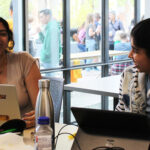
Meet student researchers advancing microelectronics, additive manufacturing and energy

This article is the first in a two-part series highlighting student researchers and faculty mentors presenting at the Spring 2023 FURI Symposium on Friday, April 21. Read part two. Learn more about the symposium.
Exploring brain-inspired computing, creating 3D printing materials for biomedical sensors, predicting additive manufacturing success and making data centers more energy efficient are just some of the ways Arizona State University students are solving real-world problems through hands-on research.
Students in the Ira A. Fulton Schools of Engineering at ASU can apply their classroom knowledge in a range of research pursuits. Their work delivers innovation that matters for challenges in data science, education, energy, health, security, semiconductor manufacturing and sustainability.
The Fulton Undergraduate Research Initiative, or FURI, and the Master’s Opportunity for Research in Engineering, or MORE, programs give students valuable experiences in which they spend a semester conceptualizing an idea, developing a plan and investigating their research question with a faculty mentor.
Students in the Grand Challenges Scholars Program, or GCSP, have the option to conduct research as part of the program’s rigorous competency requirements that prepare them to solve complex global societal challenges.
These three programs enhance students’ ability to innovate, think independently and solve problems in their communities. They also benefit from the technical and soft skills they gain, which prepare them for their careers and pursuit of advanced degrees.
Twice per year, students who participate in FURI, MORE and GCSP are invited to present their research findings at the FURI Symposium. Learn about four Fulton Schools students participating in the Spring 2023 FURI Symposium. Meet them and more than 100 other student investigators at the event, which is open to the public, on Friday, April 21, 1–3 p.m. at the Sun Devil Fitness Complex on the ASU Tempe campus.

Hailey Warner (left), an electrical engineering junior, and Priyanka Ravindran (right), an electrical engineering senior, work on semiconductor-related research projects in the FURI program under the mentorship of Ivan Sanchez Esqueda (middle), an assistant professor of electrical engineering. Photographer: Erika Gronek/ASU
Electrical engineering majors Hailey Warner and Priyanka Ravindran are working on individual research projects in the FURI program that explore memristors, an electrical component of future microelectronics that has both memory and the ability to process data. These projects, mentored by Ivan Sanchez Esqueda, an assistant professor of electrical engineering, are among the first in a new semiconductor manufacturing research theme represented at the FURI Symposium. They are also sponsored by semiconductor foundry company TSMC. This new opportunity provides a way for the global leader in the semiconductor foundry business to support ASU students conducting exceptional research on semiconductors.
Hailey Warner
Warner’s research explores the physics of 2D hexagonal boride nitride memristors, which are computing components made of a conductive ceramic material. These devices could be used in future neuromorphic, or “brain-inspired,” computing and improve machine learning hardware and neural networks.
Priyanka Ravindran
Ravindran seeks to improve machine learning through hardware in her FURI project by investigating the stacked layers of 2D materials present in neuromorphic computing devices. She hopes to further the effort of increasing computational efficiency in modern-day technology.

Photographer: Erika Gronek/ASU
Chayaank Bangalore Ravishankar
Chayaank Bangalore Ravishankar (pictured at left), a manufacturing engineering graduate student, is exploring how piezoelectric materials can improve biomedical sensors and actuators. Piezoelectricity uses tiny crystals to convert physical motion into electric signals, and piezoelectric materials are sensitive enough to detect motion in objects as small as cells. By exploring the use of 3D printing to create piezoelectric materials with his MORE project faculty mentor Xiangfan Chen (pictured at right), an assistant professor of manufacturing engineering, Ravishankar hopes to contribute to their promising future in the biomedical industry.

Photographer: Erika Gronek/ASU
Zhengbin Chen
Zhengbin Chen (pictured at right) combines his interest in data analytics and his engineering skills for his FURI project to build a model that will estimate the probability of a successful build with additive manufacturing techniques. Chen is working on this project with faculty mentor Andi Wang (pictured at left), an assistant professor of manufacturing engineering, which will help reduce waste and make the additive manufacturing process easier for all.

Photographer: Erika Gronek/ASU
Humberto Delgado
Humberto Delgado (pictured in foreground) is an electrical engineering junior conducting research in the FURI program. With his mentor, Mike Ranjram (pictured in background), an assistant professor of electrical engineering, he is working on a solution to address the size and power requirements of power supplies that provide the energy for data centers. As our online presence continues to grow, miniaturizing power electronics and making them more efficient can better meet the energy needs of data centers more sustainably.



































